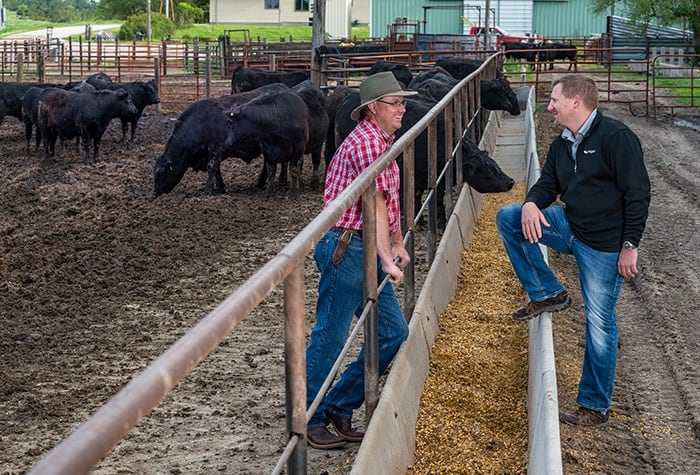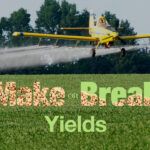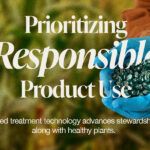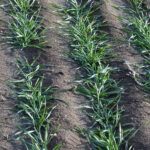Enogen Energizes Feed for Cattle
Enogen Feed corn unlocks feed’s energy potential, providing dairy and beef cattle producers with an efficient nutrition resource.

When Duane Kimball started raising Enogen® corn four years ago, he wanted the premium he could earn from a local ethanol plant. When he started growing Enogen Feed hybrids for his beef cattle this past year, he became even more convinced of the technology’s value.
“Enogen products are a win-win for ethanol and feed,” says Kimball, who has farmed full-time for 21 years in central Nebraska, near Callaway. Today, he runs 200 cow-calf pairs and backgrounds or grows steers and heifers from weaning until they enter the feedlot. He feeds his cattle Enogen Feed corn from wean through finish and has also grown Enogen Feed silage.
The advantages Kimball has experienced with Enogen Feed products come from greater starch digestibility and more available energy. “The word I use to describe Enogen Feed corn is opportunity,” says Easton Eggers, a grower account lead at Syngenta from Nebraska. “Not only can it help provide growers with additional revenue if they’re supplying corn to an ethanol plant, but it also can help improve feed efficiency when they feed it to their livestock.”
University research shows Enogen Feed corn can boost feed efficiency in cattle by an average of 5 percent.1 Duane Martin, Ph.D., commercial traits manager for corn and soybean product marketing at Syngenta, has seen the data—and the results—firsthand.
“This feed efficiency benefit has been observed consistently with Enogen Feed corn,” he says. “We see a consistent 5 percent efficiency gain at all stages of beef cattle production.”1
The Science Behind the Benefits
During the early 2000s, Syngenta researchers studied ways to modify corn to carry a specific amylase trait that helps convert starch to sugar more efficiently. The original goal? Provide corn hybrids that enhance ethanol production efficiency. “The faster the starch in corn breaks down into smaller, simpler sugars, the better,” Martin says. Enogen hybrids store this special amylase in the corn kernel’s endosperm, ready to be activated when triggered by conditions in the ethanol plant, the animal rumen and/or the silage bunker.
Syngenta first offered hybrids with the Enogen trait in 2011. Enogen corn soon attracted attention beyond ethanol plants. University trials focusing on the benefits of Enogen Feed corn for cattle feed started in 2013. As University of Nebraska–Lincoln researchers published their results, the data confirmed that Enogen Feed corn improves feed conversion in feedlot cattle.2
“Because of the unique alpha amylase in Enogen Feed corn, the feed is highly digestible, which means animals can utilize more of the nutrition in corn,” says Eileen Watson, Ph.D., global project lead for corn trait projects at Syngenta. “It has been one positive benefit after another with Enogen Feed corn.”
Dale Blasi, Ph.D., an animal science professor and extension beef specialist at Kansas State University, has studied Enogen corn versus #2 yellow corn in feed rations for post-weaning cattle. “Our studies reflect real-world conditions that growing calves face here in Kansas,” he says. “Our first study showed a 5.5 percent increase in feed efficiency among calves that were fed Enogen Feed corn.”3
There appears to be more complete digestion with Enogen Feed corn, Blasi adds. “The amylase gene provides more readily available energy in the corn, which means cattle producers have the potential to get more bang for their buck.”
Researchers have observed feed efficiency gains whether calves were fed whole corn or dry-rolled corn. The scientists saw these positive results as early as day 14 in a 90-day study. In addition, researchers tended to see lower dry-matter intake with Enogen Feed corn, Blasi says.3
“I appreciate how Syngenta goes the extra mile to substantiate the science,” says Blasi, who has also conducted Enogen Feed silage research.
Better Animal Nutrition
Enogen Feed corn silage also interests Randy Shaver, Ph.D., a professor of animal nutrition and extension dairy nutritionist from the University of Wisconsin–Madison.
“In addition to the improved starch digestibility and higher levels of available sugars, there’s also an improvement in fiber digestibility with Enogen Feed corn,” Shaver says, who has been working with Syngenta since 2016 to study the feed efficiency of Enogen Feed silage and dry corn.
This research also appeals to John Goeser, a self-described “dietitian for animals” who oversees animal nutrition research at the Rock River Laboratory, Inc., in Watertown, Wisconsin. “The improved fiber digestibility is wildly intriguing, especially since the average dairy cow only digests 60 to 65 percent of the feed she consumes.”
There’s a big difference between Enogen Feed corn and other corn when it comes to feed efficiency. It’s such a simple switch to make it part of your operation.
The variation around this average digestion is substantial, with figures ranging from 50 percent to 75 percent, Goeser adds. “Improving these numbers could have big benefits,” he says.
Practical, Proven Solutions
Syngenta also plans to expand Enogen Feed corn research into swine and poultry in the next few years. Eggers welcomes opportunities to have more data on the potential benefits of feeding Enogen Feed corn to livestock.
“With Enogen Feed corn, you don’t sacrifice yield or standability,” Eggers says, who adds that the Enogen trait is available in many corn hybrids from Syngenta. “You also have the flexibility to harvest Enogen Feed hybrids for grain or chop it for silage, with no additional agronomic challenges—unlike some silage-specific hybrids.”4
Martin encourages corn producers who grow their own grain or silage for cattle to take a close look at the benefits of Enogen Feed hybrids, with proven genetics and traits that deliver excellent agronomic performance. “There’s a big difference between Enogen Feed corn and other corn when it comes to feed efficiency,” he says. “It’s such a simple switch to make it part of your operation.”
1. University of Nebraska Lincoln Research Studies, 2013-2017; Kansas State University Research Study, 2017
2. University of Nebraska Lincoln Research Study, 2013-2017
3. Kansas State University Research Study, 2017
4. Enogen growers must comply with specific yet simple stewardship requirements.
























